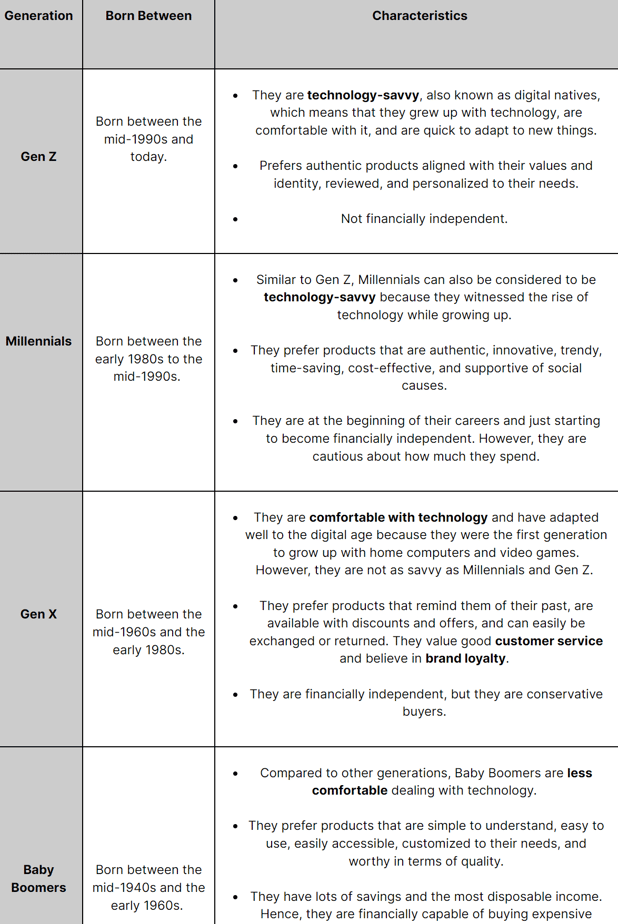Generational Segmentation: What It Is And How To Use It For E-Commerce
There is no way an eCommerce business can succeed without proper customer segmentation. Dividing your customers into groups or segments is beyond indispensable for all activities of your eCommerce store. The way you separate your target audience into distinct groups is based on the common characteristics that the members of each group share.
Research shows that segmentation makes businesses 60% more likely to understand their customers, and as the great Steve Jobs said: “It is not the customer’s job to know what they want.” This means that it is YOUR job to know what your customers want.
For you to do that, you have to understand them deeply. This is only a glimpse of the tremendous amount of benefits of customer segmentation. Therefore, you should not hesitate when it comes to investing in your customer segmentation strategy.
There are four main types of segmentation: demographic segmentation, behavioral segmentation, geographic segmentation, and psychographic segmentation.
When demographic segmentation is done based on age, it can be called “Generational Segmentation”, which is the main focus of this article. We will discuss what generational segmentation means and how it can be used for eCommerce, in addition to looking at some inspiring examples.
Table of Content:
- What is Generational Segmentation?
- How is Generational Segmentation Used in eCommerce?
- Additional Tips on How to Leverage Generational Segmentation for eCommerce.
- Allocation Of Strategies Based On Generational Segmentation
- Examples of eCommerce businesses using Generational Segmentation.
What Is Generational Segmentation?
Generational segmentation, also known as generational marketing, refers to segmenting and dividing your target audience, whether customers or prospects, into separate groups based on their age and the generation they belong to. This type of customer segmentation allows you to tailor your strategies to the needs and wants of each group based on the generation to which it belongs.
Most eCommerce businesses use generational segmentation to divide their target audience into four main generations: Generation Z, Millennials, Generation X, and Baby Boomers. To understand how generational segmentation works for eCommerce, you need to be able to distinguish between these four generations.
- Generation Z, also known as Gen Z, is the youngest generation in the market so far. This generation encompasses all people born from the mid-1990s until today.
- Millennials, also known as Gen Y, include everyone born between the early 1980s to the mid-1990s.
- Generation X, also known as Gen X, refers to those born between the mid-1960s and the early 1980s.
- Baby Boomers refers to the generation of people born between the mid-1940s and the early 1960s.
Some eCommerce businesses even market to a much older generation referred to as the “Silent Generation”, which is the oldest generation in the market and includes people born before 1945.
How Is Generational Segmentation Used In E-Commerce?
People across different generations may have some common characteristics and shared traits. However, each generation still has its unique features, attributes, and purchasing habits that should be taken into consideration to effectively target them through appropriate channels and suitable strategies.
The way generational segmentation works within the eCommerce sector is based on the previously mentioned idea. In other words, eCommerce businesses implement generational segmentation by studying the distinct features of each generational group and formulating different strategies accordingly.
Therefore, before discussing the strategies that eCommerce businesses formulate based on their generational segmentation, let’s first have a look at the different characteristics of each of the previously mentioned generations.
Gen Z:
- They are technology-savvy, also known as digital natives, which means that they grew up with technology, are comfortable with it, and are quick to adapt to new things.
- Prefers authentic products aligned with their values and identity, reviewed, and personalized to their needs.
- Not financially independent.
Millennials:
- Similar to Gen Z, Millennials can also be considered to be technology-savvy because they witnessed the rise of technology while growing up.
- They prefer products that are innovative, trendy, time-saving, cost-effective and that support social causes.
- They are at the beginning of their careers, which means that they are just starting to become financially independent. However, they are cautious about how much they spend.
Gen X:
- They are comfortable with technology and have adapted well to the digital age because they were the first generation to grow up with home computers and video games. However, they are not as savvy as Millennials and Gen Z.
- They prefer products that remind them of their past, are available with discounts and offers, and can easily be exchanged or returned. They value good customer service and believe in brand loyalty.
- They are financially independent, but they are conservative buyers.
Baby Boomers:
- Compared to other generations, Baby Boomers are less comfortable when dealing with technology.
- They prefer products that are simple to understand, easy to use, easily accessible, customized to their needs, and worthy in terms of quality.
- They are the generation with the biggest savings and most disposable income. Hence, they are financially capable of buying expensive products.

E-Commerce businesses do not invent strategies or create new ones from scratch to align with their generational segmentation. All they do is:
- Review all available marketing strategies.
- Analyze which strategy is more suitable for which age group based on its characteristics.
- Start targeting each age group with the appropriate strategy.
Allocation Of Strategies Based On Generational Segmentation
Generational segmentation saves eCommerce businesses from wasting time, effort, money, and other resources on targeting people with the wrong strategies. In this section, we will go through some of the most important strategies used by eCommerce businesses today and discuss how their implementation is affected by generational segmentation.
-
Influencer Marketing
Influencer marketing is becoming more and more popular every day. Today, many customers look to influencers for recommendations and advice. Influencer marketing can be very effective in reaching a larger audience and generating sales; however, brands need to work with influencers who are a good fit and who can be transparent about sponsored content.
The best generations to target with influencer marketing are Gen Z and Millennials. These are the generations that value social proof the most and place most of their buying decisions on it.
Check out the top 10 influencer marketing strategies for eCommerce.
-
Customer Testimonials
Customer testimonials can be a powerful tool for building trust and credibility with your target audience. E-Commerce brands are becoming more aware of the benefits of encouraging customers to leave reviews and testimonials. Brands are doing this by offering incentives and making the process straightforward.
Just like influencer marketing, customer testimonials should be used by eCommerce stores to target Gen Z and Millennials. This is because, at the end of the day, testimonials and reviews also provide a form of social proof.
-
Social Media
Research shows that the number of social media users is expected to reach 4.89 users by the end of 2023 (Statista, 2023). This is enough proof that social media is indispensable for eCommerce as it provides an avenue for brands to reach and engage with a wide array of customers.
Surprisingly, although Gen Z has never known a world without social media, research shows that they are stepping away from screens and spending less time on social media in 2023. Millennials are taking the lead when it comes to using social media. Studies show that 90.4% of Millennials use some form of social media.
Even though social media is used by some generations more than others, eCommerce brands can use it to target all generations.
-
Content Marketing
Content marketing is about offering customers informative content that helps them make informed buying decisions while also building brand awareness and loyalty. E-Commerce brands work on creating authentic content that tackles a problem that customers have while demonstrating how their products or services can help solve this problem.
The best generation that eCommerce brands can target with content marketing is the Millennials generation. Just like we mentioned earlier, Millennials appreciate authenticity. They have high levels of social, environmental, humanitarian, and political awareness. They are highly cautious when it comes to trusting marketing and they do not fall for empty promises. Therefore, content marketing is one of the best ways to target Millennials because it allows you to be your most authentic self as an eCommerce business.
-
Email Marketing
Email marketing might sound like an old marketing strategy; nevertheless, it is not something that eCommerce businesses can survive without. Its benefits are countless.
Email marketing is perfect for almost all generations. However, it is exceptionally important for Generation X because it provides them, among other things, with the customer service they need. It is the generation that values customer service the most; therefore, post-purchase emails are something that they would appreciate a lot.
-
Loyalty Programs
Most eCommerce businesses today rely heavily on loyalty programs. By providing customers with incentives and rewards for repeat purchases, brands can encourage customer retention, engagement, and loyalty. However, this technique can be effective with some generations more than others.
Generation X is the one eCommerce brands should target with loyalty programs because they are considered the most brand-loyal generation. This generation isn’t a fan of innovation. They are reluctant to change and tend to stick with what they are already familiar with. They are also attracted to discounts and offers, which they can easily find within eCommerce loyalty programs.
Moreover, loyalty programs that offer an omnichannel experience by integrating the online store with brick-and-mortar stores would be very attractive to Baby Boomers who might be more comfortable with in-store purchases and face-to-face interactions.
Discover the best types of eCommerce loyalty programs with examples.
-
Word-Of-Mouth Marketing
Word-of-mouth marketing is a strategy that involves encouraging customers to spread positive information about a brand, product, or service to their friends, family, and social networks. Just like influencer marketing and customer testimonials, this strategy is best used with those generations that care about social proof, such as Gen Z and Millennials.
-
FOMO Marketing
FOMO marketing is a strategy that leverages the fear of missing out (FOMO) to drive sales and conversions. It works by creating a sense of urgency and exclusivity around a certain product or service and there is a technique related to it called “Scarcity Marketing”.
Research shows that Millennials are affected by FOMO marketing the most. To better illustrate, around 69% of Millennials experience FOMO.
-
Artificial Intelligence
Artificial intelligence is one of the digital marketing trends for eCommerce in 2023. When we say artificial intelligence, we mean fascinating technology such as ChatGPT, the metaverse, augmented reality (AR), virtual reality (VR), and others. It goes without saying that eCommerce businesses use AI to target mainly Gen Z and Millennials.
- Omnichannel Marketing
Omnichannel marketing is about providing a consistent brand message, and a seamless and integrated shopping experience for customers across multiple channels.
Adopting this marketing strategy would benefit you in targeting all generations.
Additional Tips On How To Leverage Generational Segmentation For E-Commerce
- Personalization is another effective technique that can be directed toward targeting specific generations. Based on the generations’ characteristics that we’ve discussed earlier, eCommerce personalization would be very suitable for targeting Gen Z who are always looking for personalized products and services that reflect their distinct personalities.
- Within Content marketing, User-generated content might come in handy when targeting Millennials. However, search-engine-optimized content might be more effective when targeting Gen X who are more likely to research products using keywords before making a final buying decision.
- Further market analysis would be needed with your generational segmentation to understand the buyer motivation of each generation.
- You might need to pursue traditional marketing, such as print, radio, and TV if you are planning on targeting Baby Boomers. However, do not underestimate their ability to navigate through social media.
- Do not forget to play on the nostalgia aspect when targeting Gen X. They are big on things that remind them of their past.
- Generational segmentation can yield better results if combined with other types of demographic segmentation based on gender, education, marital status, and income.
- Supporting a social or a charitable cause is always good for your eCommerce brand; however, its importance is highlighted when trying to target Millennials.
- If you ever decide to target the Silent Generation, make sure you adhere to what they value the most, such as family, community, and respect. Use the most traditional marketing techniques you can think of. For example, use TV, radio, or even direct mail.
- DO NOT rigidly believe in the stereotypes of generational segmentation. In other words, allow room for some flexibility and acceptance of the fact that not all stereotypes related to generations are still true. For example, it is very easy to fall for the idea that Baby Boomers are old people who cannot use technology. However, I bet that your grandmother shares more posts on Facebook than you do.
Examples Of E-Commerce Businesses Using Generational Segmentation
There is no shortage of eCommerce brands that use generational segmentation. Let’s have a look at a few examples to gain a better understanding of how such a technique is used.
- E-Commerce brand targeting Gen Z:
Under Armour’s marketing campaign in collaboration with the American professional basketball player Steph Curry perfectly targeted Gen Z using all the suitable marketing strategies and tactics that we’ve discussed in this article.
- They collaborated with an influencer (a celebrity) because they knew it would give Gen Z the kind of social proof they needed.
- The campaign’s video included jump-cuts and upbeat music which perfectly appeals to Gen Z.
- They ended the video with a powerful statement saying, “ Ignore the hate. Keep doing you.” This message highly resonates with Gen Z, who prefer brands taking a stance against bullying and hate. Today, Gen Z wants to be themselves without feeling shame or having to deal with hate. Under Armour knows that and successfully addresses it in its campaign.
- E-Commerce brand targeting Millennials:
Warby Parker’s marketing campaigns target Millennials in the best way by communicating with their socially-conscious minds. Warby Parker has targeted Millennials by positioning itself as a brand that values sustainability and giving back. The company has a "Buy a Pair, Give a Pair" program where they donate a pair of glasses to someone in need for every pair purchased. This initiative aligns with Millennials' growing interest in social responsibility and charitable causes.
- E-Commerce brand targeting Gen X:
Casper is a mattress company that offers high-quality, comfortable mattresses delivered directly to consumers' homes. Casper is another example of an eCommerce brand using generational segmentation. In this example, the target audience is mainly Gen X.
- Casper appeals to Gen X by offering a 100-night sleep trial, a 10-year warranty, and free shipping and returns. This makes sense when we remember what we said at the beginning of this article about Gen X preferring products that can easily be exchanged or returned.
- Casper is also aware of the fact that, even though Gen X are financially independent, they are still conservative in their buying decisions because they have lots of financial obligations and responsibilities. Therefore, Casper goes out of their way to prove to their customers that products are worthy of their money in terms of quality, comfort, and convenience.
- E-Commerce brand targeting Baby Boomers
Hubble is an online retailer that sells affordable, high-quality contact lenses. It is an eCommerce brand that uses generational segmentation. Among the age groups that Hubble targets successfully are the Baby Boomers.
Hubble's marketing strategy perfectly meets the Baby Boomers' needs and preferences for convenience. For instance, the brand offers a subscription service for contact lenses that delivers fresh lenses directly to customers' doors regularly. It can’t get more convenient than that!
Hubble’s products are of good quality, easily accessible for Baby Boomers, and fit their needs.
Final Thoughts:
You now know everything you need to learn about generational segmentation. We have thoroughly discussed what generational segmentation means and how it can be used for eCommerce. We’ve also seen some examples of brands successfully employing this type of customer segmentation. Now all you need is an automation tool to help make this whole process easier.
Don’t worry; we’ve got your back in that too!
Converted.In is offering you a great automation tool that can do the following:
- Conduct all types of customer segmentation for you.
- Create, customize, launch, and automate personalized ads, SMS, and email marketing campaigns.
- Gather your customers’ data, which may be scattered across different places, into one place, like a hub.
Book your demo now and get yourself a tool that can conduct the generational segmentation process for you.
 By
By

